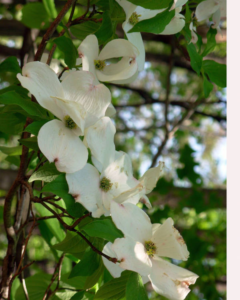Ripples by Kennedy Zittel, Assistant Naturalist
 It is finally spring, and that means that it is almost time to start all of those yard work projects that we have been thinking about all winter long. I recently bought my first house, and I have been beyond excited to get to plant a garden and plant native flowers/shrubs in the yard.
It is finally spring, and that means that it is almost time to start all of those yard work projects that we have been thinking about all winter long. I recently bought my first house, and I have been beyond excited to get to plant a garden and plant native flowers/shrubs in the yard.
Looking at the current landscaping certainly makes that seem quite daunting though. Invasive shrubs line the house, and though it pains me to see, I can’t overly blame the past owner. Not many people know when they put in those plants how bad they truly are. In fact, even though European barberry/common barberry (Berberis vulgaris) is listed as prohibited in the state of Wisconsin, you can still buy it at many greenhouses and landscaping companies.
Many invasive plants become a problem due to how pretty they look. Plants like barberry, buckthorn, and honeysuckle were all brought here and used in landscaping, and now, are listed as invasive. What started out innocently enough, just bringing them here because they are pretty, goes downhill quite quickly. First, birds will eat the berries off of the plants and spread those seeds whenever they go to the bathroom. Because no local wildlife is used to these new plants, there will be little to no predators to eat the young plants. Since there are no predators, those plants will all grow to be full-sized. Then, because the native plants aren’t used to the competition from those new plants, the native ones end up dying because they don’t get enough sunlight or space to grow. Now that the native plants are all gone, the new plants will spread and spread, taking over huge areas of land and killing and crowding out more native plants as they go. This is why they are then deemed invasive.
We at Woodland Dunes spend a lot of time removing invasive plants like barberry, buckthorn, and honeysuckle from our preserve to help the native plants and wildlife. Luckily, as more people learn about the issues of planting invasive plants in their landscaping, fewer will end up escaping and getting into the forests. Also, as more people hear about the issues of invasives, more and more people have been removing those plants from their yards, which helps stop the spread of new invasives.
But this doesn’t mean that your yard has to look ugly. We have plenty of beautiful native plants in Wisconsin that could take the place of the bad ones. In fact, some of these native ones are even prettier than the invasive ones and have a ton of awesome wildlife benefits too! For example, common ninebark, elderberry, and the native dogwood species all have beautiful flowers in the spring, nice full leaves in the summer, berries that the birds will love, and leaves that turn colors in the fall! And, some even have colorful branches in the winter like the red-osier dogwood! These plants look nice and birds love to nest, shelter in, and eat the berries too. Pollinators will also be super happy with those choices, as they love the flowers!
We also have a ton of native wildflowers that could add a ton of color to your yard! Reds, oranges, yellows, greens, blues, purples, pinks, whatever color you want, there is a native wildflower that fits it! Cardinal flowers, scarlet beebalm, and royal catchfly add some red, butterfly weed adds a bright pop of orange, black-eyed Susans, lance-leaf coreopsis, yellow coneflower, add happy yellow colors, many plants come in green like the leaves of mountain mint, great blue lobelia adds an unusual pop of blue, purple coneflower, blazing star, and wild bergamot all add purple that is a welcomed sight to both people and pollinators alike!
Pollinators will all love those plants too, and some of those plants attract birds with their seeds in the fall. Planting native plants in your yard can not only make your yard pleasing to look at, but can also help the wildlife and environment too!
photo from US Fish & Wildlife Digital Library
